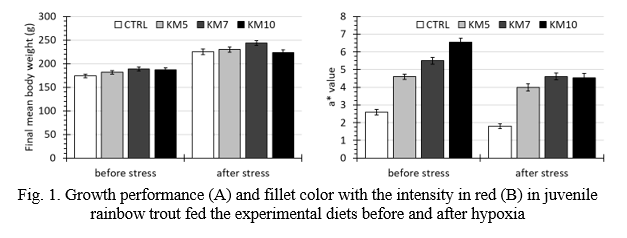EFFECTS OF KRILL MEAL ON HYPOXIA TOLERANCE IN RAINBOW TROUT Oncorhynchus mykiss: EXPLORING SEX-DEPENDENT RESPONSES
Introduction
Salmonids are sensitive to low dissolved oxygen (DO) levels, with sudden drops often triggered by high temperatures, fish density, or handling. Climate change may increase the frequency of such events, affecting fish welfare and performance. Antioxidant micronutrients like selenium, vitamin C, and astaxanthin are promising tools to enhance stress resilience. Selenium supplementation has been shown to improve hypoxia tolerance in trout fry fed plant-based diets (Wischhusen et al., 2020), with evidence suggesting sex-related differences in oxidative stress responses (Schomburg and Schweizer, 2009). Krill meal (KM), naturally rich in antioxidants, has shown benefits for growth, flesh quality, and fish health (Kaur et al., 2022, Tran et al., 2025). This study investigated the effects of KM on juvenile rainbow trout performance, antioxidant responses under hypoxia, and sex-related metabolic differences.
Materials and methods
Four experimental diets were tested: a control diet (CTRL) containing 10% fishmeal, and three diets in which krill meal (KM) replaced the marine fraction (fishmeal + fish oil) at 5% (KM5), 7.5% (KM7), and 10% (KM10). Groups of 60 juvenile rainbow trout (37 ± 1 g), of mixed sex, were randomly distributed into triplicate tanks per treatment and fed their respective diets for 12 weeks at 17 ± 1 °C, with DO maintained above 9 mg/L. At the end of the feeding period, 30 fish per tank were euthanized for tissue collection. The remaining fish were subjected to chronic hypoxia (< 6 mg/L DO) for an additional 3 weeks before final sampling. Growth performance, feed intake, and survival were monitored throughout the trial. Feces were collected by stripping for digestibility analysis. Fillet color, sex, whole-body composition, liver antioxidant status, plasma stress indicators, and blood proteomic profiles were assessed. Data were analyzed by ANOVA and presented as means ± SEM.
Results
Fish fed the KM7 diet showed improved growth performance both before and after the chronic hypoxia challenge (Fig. 1A). Chronic hypoxia significantly reduced fillet redness, whereas KM inclusion enhanced it in a dose-dependent manner, likely due to its natural astaxanthin content, as all KM groups showed higher redness than the control both before and after hypoxia (Fig. 1B).
Discussion
This study shows that KM inclusion improves growth performance and fillet quality in juvenile rainbow trout, particularly under chronic hypoxia. The 7.5% KM diet (KM7) was especially effective, suggesting that antioxidant-rich ingredients such as KM can enhance fish resilience to oxygen deprivation. Improved fillet redness under hypoxic conditions, likely linked to dietary astaxanthin, further supports this protective effect. These findings are consistent with previous work by Kalinowski et al. (2019), who demonstrated that dietary astaxanthin improved hepatic oxidative stress tolerance in trout exposed to hyperoxia. The antioxidant components of KM, including astaxanthin and selenium, may thus play a key role in mitigating stress-induced oxidative damage.
A notable finding is the potential for sex-dependent differences in hypoxia responses. Ongoing analyses aim to determine whether the effects of KM differ between males and females, particularly regarding antioxidant pathways. Previous studies have reported sex-specific oxidative stress responses (Schomburg and Schweizer, 2009), but these remain to be fully characterized in the present study. Further investigation of liver antioxidant status, plasma stress markers, and whole-body composition will provide deeper insights into the physiological adjustments associated with hypoxia and KM supplementation.
Conclusion
KM appears to improve hypoxia tolerance in rainbow trout, potentially through its antioxidant properties and with possible sex-specific effects. These results have important implications for aquaculture, offering a nutritional strategy to enhance fish welfare and performance under climate-induced environmental stress.
Acknowledgements
This work was supported by the EU H2020 Research Innovation Program (AQUAEXCEL3.0, PID30017).
References
Kalinowski, C.T., Larroquet, L., Véron, V., Robaina, L., Izquierdo, M.S., Panserat, S., Kaushik, S., Fontagné-Dicharry, S., 2019. Influence of dietary astaxanthin on the hepatic oxidative stress response caused by episodic hyperoxia in rainbow trout. Antioxidants 8, 626. https://doi.org/10.3390/antiox8120626
Kaur, K., Kortner, T.M., Benitez-Santana, T., Burri, L., 2022. Effects of antarctic krill products on feed intake, growth performance, fillet quality, and health in salmonids. Aquac. Nutr. 2022. https://doi.org/10.1155/2022/3170854
Schomburg, L., Schweizer, U., 2009. Hierarchical regulation of selenoprotein expression and sex-specific effects of selenium. Biochim. Biophys. Acta 1790, 1453-1462. http://dx.doi.org/10.1016/j.bbagen.2009.03.015
Tran, H.Q., Nguyen, T.T., Prokešová, M.D., Øverland, M., Gasco, L., Kumar, V., Van Doan, H., Stejskal, V., 2025. Impact of krill (Euphausia superba) meal on growth performance of aquatic animals: A meta-analysis and prospective directions. Anim. Nutr. 20: 487-498. https://doi.org/10.1016/j.aninu.2024.11.024
Wischhusen, P., Larroquet, L., Durand, T., Oger, C., Galano, J.-M., Rocher, A., Vigor, C., Jesu Prabhu, P.A., Véron, V., Briens, M., Roy, J., Kaushik, S.J., Fauconneau, B., Fontagné-Dicharry, S., 2020. Oxidative stress and antioxidant response in rainbow trout fry exposed to acute hypoxia is affected by selenium nutrition of parents and during first exogenous feeding. Free Radic. Biol. Med. 155, 99-113. https://doi.org/10.1016/j.freeradbiomed.2020.05.006
